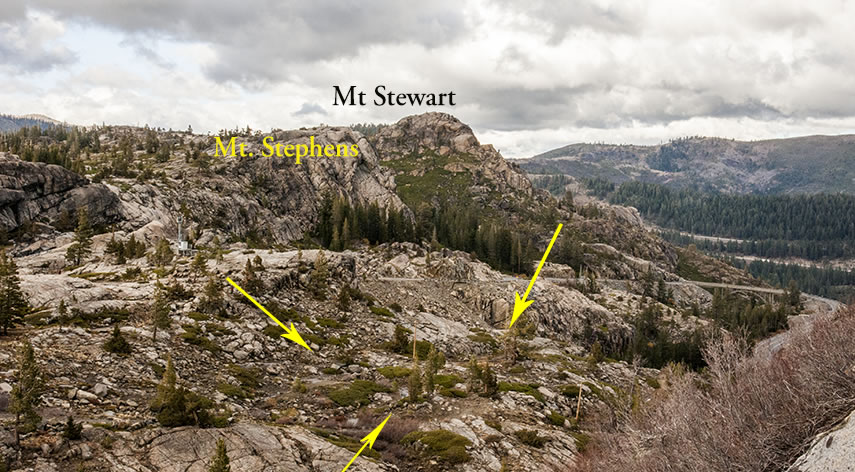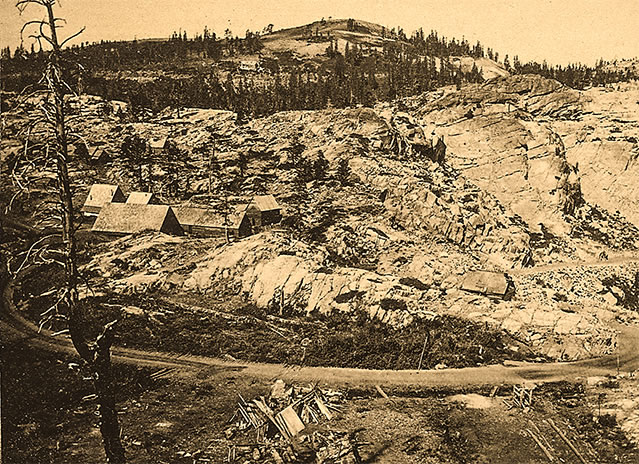“Without the Chinese, it would have been impossible to complete the Western portion of this great national highway.” Leland Stanford

The job of building the railroad across the Sierra went to the Chinese workers who made up 80% or more of the Central Pacific’s workforce. All along the Transcontinental railroad line there were workers’ camps. Most were transitory in nature. Once the rails were laid in one place the workers moved on to the next section needing attention. At the summit, though, workers worked for years on the tunnels and so the camps were less temporary and in use for a few years.
As you walk up the first set of switchbacks on the Judah Loop Trail look over to the area the arrows delineate in the picture here. There sat Summit Camp, the longest lasting of the Chinese railroad worker camps. Several hundred Chinese workers lived just a very short commute from their work during the two year construction of Tunnel 6 and afterwards. Workers lived in actual builidings as opposed to the "dog kennel" (California novelist Bret Harte's description) like structures they lived in at other more temporary camps.
The picture below is by Alftred A. Hart (#116 "Camp Near Summit Tunnel, Mt. King in the distance*), taken about 1869 showing the buildings in the area the arrows mark above. The road in front is the Dutch Flat Donner Lake Wagon Rd. (later the Linocln Highway).
 In winter on Donner Summit where snowfall averages 34 feet, some workers did not see the sun for months at a time as they traveled from living quarters to the tunnel rock faces through tunnels dug into the snow. A whole work community was dug into the snow: blacksmith shops, storage,
kitchens, stables, etc.
In winter on Donner Summit where snowfall averages 34 feet, some workers did not see the sun for months at a time as they traveled from living quarters to the tunnel rock faces through tunnels dug into the snow. A whole work community was dug into the snow: blacksmith shops, storage,
kitchens, stables, etc.
Today there is only the site of Summit Camp. Over time there has been a lot of activity nearby. A petroleum pipeline crosses the summit right through or just next to the Summit Camp site. There were leaks in that pipeline. Both the construction of the pipeline and the fixing of the leaks brought in machinery and activity that no doubt affected the Summit Camp site. A fiber optic cable crosses the summit at the Summit Camp site as does the first transcontinental telephone line. The Summit Camp site sits near the Pacific Crest Trail which brings a lot of people nearby. There is a trail following the old Lincoln Highway from the summit to Donner Lake (see our brochure with map, “Donner Pass Summit Canyon” (pg 1 and pg 2)on our “Brochures” web page or at the DSHS) which is right next to the site too. The Lincoln Highway, the first transcontinental highway also goes right next to the site. So there have been a lot of people in the neighborhood, at least a few of whom affected the site.
Still, it was the archeological investigations that have affected the site the most. There was archeological activity four times and a lot of material was removed. If you go look over the site you can see the outlines of building foundations and small bits of other history.
There's really a lot to read about the Chinese workers. If you are interested go to the 2016 Heirloom web pages and open up the PDF's beginning in June.
*Mt. King is today Signal Hill at Donner Ski Ranch.

